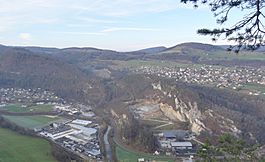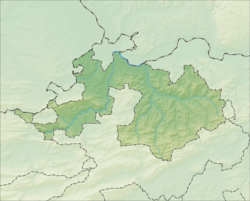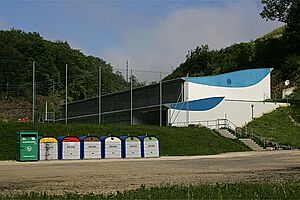Liesberg facts for kids
Quick facts for kids
Liesberg
|
||
|---|---|---|
 |
||
|
||
| Country | Switzerland | |
| Canton | Basel-Landschaft | |
| District | Laufen | |
| Area | ||
| • Total | 12.46 km2 (4.81 sq mi) | |
| Elevation | 521 m (1,709 ft) | |
| Population
(Jun 2021 )
|
||
| • Total | 1,111 | |
| • Density | 89.17/km2 (230.94/sq mi) | |
| Postal code |
4253
|
|
| Surrounded by | Bärschwil (SO), Courroux (JU), Kleinlützel (SO), Laufen, Roggenburg, Röschenz, Soyhières (JU) | |
Liesberg is a small town, also called a municipality, located in the Laufen district. It's part of the canton of Basel-Country in Switzerland.
Contents
History of Liesberg
Liesberg was first mentioned in official records way back in 1281. At that time, it was known as Liesperch.
Geography and Nature
Liesberg covers an area of about 12.49 square kilometers (which is about 4.8 square miles). A big part of this land, about 36.6%, is used for farming. This means there are fields and pastures where crops are grown or animals graze.
Even more of Liesberg, about 53.3%, is covered by forests. These are thick woods, and some areas have fruit trees or small groups of trees.
About 8.8% of the land is developed, meaning it has buildings or roads. A small part, 0.5%, includes rivers or lakes. The rest, about 1.0%, is land that isn't used for farming or building.
Liesberg is nestled in the Laufen district, right along the Blauen mountains. The main part of the town is a haufendorf village. This means it's an old-fashioned village with an unplanned, close-packed layout, often built around a central area. Liesberg also includes smaller areas called hamlets like Riederwald and Oberrüti, plus an industrial area known as Liesberg-Station.
Town Symbols: The Coat of Arms
The blazon (official description) of Liesberg's coat of arms is quite unique. It shows a swan walking on six red hills, which rise from two wavy black lines. The background color is blue. This design represents the town's history and features.
People and Population
Liesberg has a population of about 1,214 people (as of 2022). A small number of these residents, about 9.3%, are people from other countries. Over the past ten years (1997–2007), the population has grown slowly, by about 0.9%.
Most people in Liesberg, about 93%, speak German. This is the main language. After German, the next most common languages are Serbo-Croatian (1.6%) and French (1.5%).
In 2008, about 52.2% of the people in Liesberg were male, and 47.8% were female. Most residents, about 89.4%, are Swiss citizens. The remaining 10.6% are non-Swiss residents.
Many people in Liesberg were born there. In 2000, about 49.8% of the population were born in Liesberg and still lived there. Others were born in the same canton (11.7%), elsewhere in Switzerland (26.6%), or outside Switzerland (8.4%).
The age groups in Liesberg (as of 2010) are:
- Children (0-6 years old): 5.5%
- Teenagers (7-19 years old): 15.2%
- Young adults (20-29 years old): 11.0%
- Adults (30-39 years old): 10.2%
- Adults (40-49 years old): 18.8%
- Adults (50-64 years old): 22.2%
- Seniors (65-79 years old): 12.5%
- Seniors (over 80 years old): 4.5%
In 2000, there were 455 private households in Liesberg, with an average of 2.5 people living in each home. About 26.6% of these households had only one person. There were also 155 married couples with children and 21 single parents with children.
Most of the homes in Liesberg are single-family houses. In 2000, about 65.7% of the inhabited buildings were single-family homes. Many of these were built between 1990 and 2000.
The historical population of Liesberg has changed over time, as shown in this chart:

Important Sights
The entire Liesbergmüli area is recognized as an important Swiss heritage site. This means it's a special place with historical or cultural value that is protected.
Economy and Jobs
In 2007, Liesberg had a low unemployment rate of 1.69%. This means most people who wanted jobs had them.
Many people in Liesberg work in different types of jobs:
- Primary sector: This includes jobs like farming and forestry. In 2005, about 43 people worked in this area.
- Secondary sector: This involves manufacturing, mining, and construction. In 2005, about 505 people worked in these fields.
- Tertiary sector: This covers service jobs, like retail, transportation, hotels, restaurants, healthcare, and education. In 2005, about 107 people worked in these services.
In 2008, there were 708 full-time equivalent jobs in Liesberg. A large number of these, 571, were in the secondary sector, mostly in manufacturing. The tertiary sector had 105 jobs, including roles in sales, transport, hospitality, and healthcare.
Liesberg is a place where more people come to work than leave for work. In 2000, 565 workers traveled into the municipality, while 357 traveled out. This means Liesberg has more jobs available than local workers. About 23.2% of the people who come to work in Liesberg are from outside Switzerland.
When it comes to getting to work, about 20.5% of workers used public transportation, and 43.1% used a private car.
Religion in Liesberg
Based on the 2000 census, most people in Liesberg are Roman Catholic, making up about 74.3% of the population. Another 11.4% belong to the Swiss Reformed Church.
There are also smaller groups of other Christian faiths, including Orthodox Christians and members of the Christian Catholic Church. About 1.39% of the population are Islamic, and a few individuals are Hindu.
About 7.22% of the population said they didn't belong to any church, or were agnostic or atheist.
Education and Learning
In Liesberg, about 36.2% of the population have finished upper secondary education, which is like high school. About 7.4% have gone on to higher education, either at a university or a specialized college (a Fachhochschule).
In 2000, only four students living in other towns came to school in Liesberg. However, 60 students from Liesberg went to schools outside the municipality.
Images for kids
See also
 In Spanish: Liesberg para niños
In Spanish: Liesberg para niños








